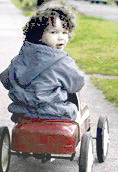

Our
mission is to reduce the number of injuries and deaths due to
injuries,
through prevention, improved trauma care, and improved rehabilitation.
More laws exist in the U.S. that protect animals from being left unattended in a vehicle than exist to protect children from the same dangers.
"It happened in less time than it takes to turn around. Everything changed in an instant."
May 16, 2002
.
Not Even For a Minute
When a child dies from an incurable disease, people rightly feel a helpless sense of sorrow, and push harder to find a cure so that no other child may die. Finding a cure for such a disease may take millions of dollars, countless hours of research, and many years.
When a child dies as a result of being left unattended in or around an automobile, people call it a freak, tragic accident. Yet each year many children are injured or die from these preventable situations. This year there have been thirteen cases in which young children died as a result of having been backed over by motor vehicles, frequently in close proximity to their own homes.
Defining The Problem
Well-meaning parents and caregivers leave children alone or unattended around motor vehicles every day for a variety of reasons, but primarily because they are unaware of the dangers present in doing so, even for a minute. They simply don't realize that very young children may not be visible to the driver of any motor vehicle.
Caregivers also may not understand that young children cannot comprehend the danger present around a moving vehicle. Children can quickly slip, unnoticed, out of the house and into harm's way. Because they are impulsive, unpredictable, and do not understand boundaries such as property lines, sidewalks, driveways, or streets, they are unable to protect themselves around motor vehicles. Warning noises such as back-up beepers and alarms are ineffective with young children.
What You Can Do Now to Keep Children Safe
- Determine the areas around your vehicle where you cannot see a child (blind spots). Sit in the driverís seat of the vehicle and have another adult take your child around the vehicle to determine areas where you can and cannot see them in the rear view mirrors.
- Always walk around and behind the vehicle prior to moving it.
- Know where children are, or have them in sight, prior to moving the vehicle. If they are nearby, be sure children are being properly supervised by another adult before moving the vehicle.
- Reassess your family vehicle's safety.
What Else Can Be Done
Vehicle design changes
Ideally, all vehicles should include, either through retro-fit or from the manufacturer:
- Cross rear view mirrors
- Back up detection devices - cameras, sensors
Legislation and Regulation Are Needed
- We need federal regulations requiring improved visibility behind vehicles.
- Only ten states have laws regarding leaving children unattended in or around motor vehicles.
- Auto manufacturers should be required to provide warnings about the dangers.
- Commercial vehicles should be required to have cross rear view mirrors or other technology to detect small children around and behind vehicles.
- Product redesign in automobiles should incorporate child-related injuries and deaths. The National Highway Safety and Traffic Association (NHSTA) currently does not place emphasis on non-traffic injuries and/or deaths.
Environmental Considerations
The environment of young children can be made more safe by considering:
- Barriers to prevent access of young children to areas with moving motor vehicles
- Convex mirrors for driveways
- Steep inclines be adjusted to compensate for blind spots.
Raise Awareness
Information about the problem should be included in:
- driver education
- driving school curriculum
- day care providers education
- parenting education
- school and passenger safety courses.
 |
 |
|---|